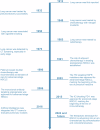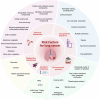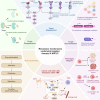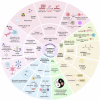Advances in molecular pathology and therapy of non-small cell lung cancer
- PMID: 40517166
- PMCID: PMC12167388
- DOI: 10.1038/s41392-025-02243-6
Advances in molecular pathology and therapy of non-small cell lung cancer
Abstract
Over the past two decades, non-small cell lung cancer (NSCLC) has witnessed encouraging advancements in basic and clinical research. However, substantial unmet needs remain for patients worldwide, as drug resistance persists as an inevitable reality. Meanwhile, the journey towards amplifying the breadth and depth of the therapeutic effect requires comprehending and integrating diverse and profound progress. In this review, therefore, we aim to comprehensively present such progress that spans the various aspects of molecular pathology, encompassing elucidations of metastatic mechanisms, identification of therapeutic targets, and dissection of spatial omics. Additionally, we also highlight the numerous small molecule and antibody drugs, encompassing their application alone or in combination, across later-line, frontline, neoadjuvant or adjuvant settings. Then, we elaborate on drug resistance mechanisms, mainly involving targeted therapies and immunotherapies, revealed by our proposed theoretical models to clarify interactions between cancer cells and a variety of non-malignant cells, as well as almost all the biological regulatory pathways. Finally, we outline mechanistic perspectives to pursue innovative treatments of NSCLC, through leveraging artificial intelligence to incorporate the latest insights into the design of finely-tuned, biomarker-driven combination strategies. This review not only provides an overview of the various strategies of how to reshape available armamentarium, but also illustrates an example of clinical translation of how to develop novel targeted drugs, to revolutionize therapeutic landscape for NSCLC.
© 2025. The Author(s).
Conflict of interest statement
Competing interests: The authors declare no competing interests.
Figures













Similar articles
-
Resistance to immunotherapy in non-small cell lung cancer: Unraveling causes, developing effective strategies, and exploring potential breakthroughs.Drug Resist Updat. 2025 Jul;81:101215. doi: 10.1016/j.drup.2025.101215. Epub 2025 Feb 25. Drug Resist Updat. 2025. PMID: 40081220 Review.
-
Molecularly targeted therapies in non-small-cell lung cancer annual update 2014.J Thorac Oncol. 2015 Jan;10(1 Suppl 1):S1-63. doi: 10.1097/JTO.0000000000000405. J Thorac Oncol. 2015. PMID: 25535693 Free PMC article.
-
Advancements in NSCLC: From Pathophysiological Insights to Targeted Treatments.Am J Clin Oncol. 2024 Jun 1;47(6):291-303. doi: 10.1097/COC.0000000000001088. Epub 2024 Feb 20. Am J Clin Oncol. 2024. PMID: 38375734 Free PMC article. Review.
-
Acquired resistance to targeted therapies in NSCLC: Updates and evolving insights.Pharmacol Ther. 2020 Jun;210:107522. doi: 10.1016/j.pharmthera.2020.107522. Epub 2020 Mar 6. Pharmacol Ther. 2020. PMID: 32151666 Free PMC article. Review.
-
Top advances of the year: Targeted therapy for lung cancer.Cancer. 2024 Oct 1;130(19):3239-3250. doi: 10.1002/cncr.35423. Epub 2024 Jun 21. Cancer. 2024. PMID: 39031586 Review.
Cited by
-
Avicularin induces apoptosis in NSCLC by promoting USP7-mediated degradation of FOXM1.Naunyn Schmiedebergs Arch Pharmacol. 2025 Aug 11. doi: 10.1007/s00210-025-04529-6. Online ahead of print. Naunyn Schmiedebergs Arch Pharmacol. 2025. PMID: 40788482
-
Antitumor Activity of Isalpinin from Paphiopedilum dianthum on Non-Small Cell Lung Cancer Cell Lines.Molecules. 2025 Jun 27;30(13):2762. doi: 10.3390/molecules30132762. Molecules. 2025. PMID: 40649280 Free PMC article.
-
Multiscale information processing in the immune system.Front Immunol. 2025 Jul 21;16:1563992. doi: 10.3389/fimmu.2025.1563992. eCollection 2025. Front Immunol. 2025. PMID: 40761781 Free PMC article. Review.
References
-
- Spiro, S. G. & Silvestri, G. A. One hundred years of lung cancer. Am. J. Respir. Crit. Care Med.172, 523–529 (2005). - PubMed
-
- Bray, F. et al. Global cancer statistics 2022: GLOBOCAN estimates of incidence and mortality worldwide for 36 cancers in 185 countries. CA Cancer J. Clin.74, 229–263 (2024). - PubMed
-
- Siegel, R. L., Miller, K. D., Wagle, N. S. & Jemal, A. Cancer statistics, 2023. CA Cancer J. Clin.73, 17–48 (2023). - PubMed
-
- Soerjomataram, I. & Bray, F. Planning for tomorrow: global cancer incidence and the role of prevention 2020-2070. Nat. Rev. Clin. Oncol.18, 663–672 (2021). - PubMed
Publication types
MeSH terms
LinkOut - more resources
Full Text Sources
Medical
Miscellaneous

